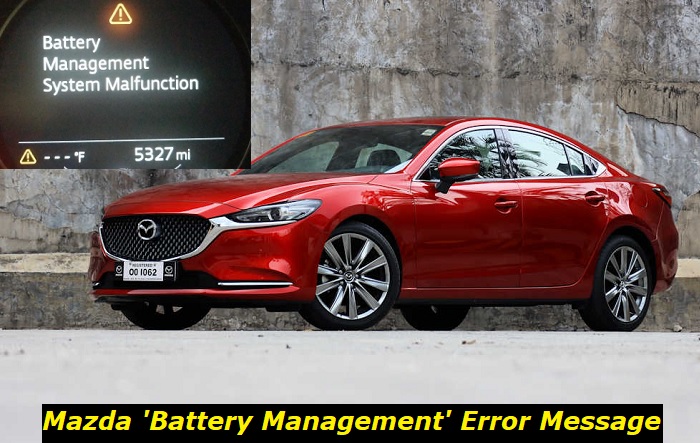A Battery Management System (BMS) monitors the charging and discharging of your Mazda's battery. Batteries perform best under certain conditions, and the BMS helps to maintain optimum conditions. The BMS also checks the battery and the charging system for any problems and sends alerts when it detects them. One of the alerts the BMS might send is "battery management system inspection required". What is this, and what does it mean?
Battery management system inspection required message highlights
- Common reasons:battery management control module failure, low battery, issues with alternator
- How to fix:check the battery, check the alternator, verify your car is not in the service bulletin
- Possible consequences:battery may die
- Priority level:Medium
- Can you drive?Yes
- DIY repair:Possible but complicated
- Repair price range:$0-$350

What Does "Battery Management System Inspection Required" Mean?
When "battery management system inspection required" appears on your dashboard, you might be a little confused about what it means. It's your Mazda's way of letting you know that there's a problem with your car's battery or its charging system. This could affect your battery's performance, reducing its lifespan, or keeping it from charging.
The battery management system in your Mazda uses data from different sensors to check on your battery's health. Abnormal temperatures, voltage, or current will make the system alert you of a problem. This will bring up the "battery management system inspection required" warning.
Your Mazda's battery system is made up of many different parts that work together to charge and run the battery. This means that there are a lot of things that could go wrong. A problem with any of these parts could trigger the "battery management system inspection required" warning.
What Causes the "Battery Management System Inspection Required" Warning?
There are many issues that can cause the "battery management system inspection required" warning. Here we'll take a look at the problems that can develop in the battery system to bring this problem up.
1) Weak or Old Battery
It should be no surprise that the battery is the first place to check when you're trying to diagnose a BMS problem. The most common cause of this warning is battery issues. The battery management system monitors your battery voltage to make sure that it's in the correct range. If the voltage is too low, certain electronics won't be able to function. When the voltage is too high, it can damage some of the car's electronics, so the battery management system will send a warning.
A weak battery will cause a lot of issues with how your car's systems run. Here's how you'll know that a weak battery is the source of your troubles.
2) Weak or Malfunctioning Electronics
Your car's battery powers the electronic systems in your car. Your air conditioning, heater, power windows, and lights all draw their power from the battery. If the battery is putting a lower voltage than normal, then these components will work weakly or not at all.
This means you're likely to notice dim lights and slow windows. Certain systems that require more power, such as the radio or infotainment system might reboot repeatedly. They might not even start up at all.
3) Hard Starting
Turning on the ignition in a healthy car should start the engine easily. Turning on the ignitions sends a signal to the starter motor to crank the engine. The starter motor uses up a lot of electricity from the battery. If the battery voltage is too low, the starter motor will have a hard time cranking the engine. This means you might need more and more attempts to get the engine started.
Apart from hard starting, your engine might not even start at all. This happens when the battery dies completely. This means that you'll end up with a no-start condition. You'll need to jumpstart your car to get it started. If you find yourself jumpstarting your car more often, then you should definitely check out your battery.
4) Your Battery No Longer Holds a Charge
A telltale sign of a bad battery is when it can't hold a charge for too long. If your battery needs to be charged more frequently, it's probably gone bad. Eventually, the battery might not even charge anymore.
5) Worn or Broken Serpentine Belt
After inspecting your battery, you should check out your car's serpentine belt next. The serpentine belt provides power to several different components under the hood. This belt transfers power from the engine to parts like the AC compressor, water pump, and alternator. Like any belt in your car, it can start to wear down, stretch or slip. This will make the belt less effective at transmitting power. As a result, the attached components could start to malfunction or fail.
This can cause a lot of different problems to start coming up in your car, but what we're really concerned with here is the alternator. When the serpentine belt starts to fail, the alternator will get less power from the engine. This means that it's going to generate less energy to charge the battery, causing the BMS to send a warning.
In most cases, the serpentine belt will just be a little loose or worn. Sometimes the belt might snap completely, leaving the alternator with no way to generate power. This will leave you with a battery that has no way to charge.
6) Faulty Alternator
Whenever you start your car and drive around, the alternator charges your battery. The alternator is basically an electrical generator under your hood. The alternator takes part of the mechanical energy produced by the engine and converts it into electricity to charge the battery and power the car's electronics.
It's clear that a problem with the alternator would prevent your battery from charging. If your alternator breaks down or fails, the battery won't charge. Eventually, your battery will die completely. The battery management system prevents this by sending a warning when it detects something wrong with the alternator.
What Should You Do About "Battery Management System Inspection Required"?
Now that you know what causes a "battery management system inspection required" warning, what should you do to get rid of it? It's usually best to follow whatever your car's warnings tell you to do. In this case, you need to inspect the system.
1) Replace the Battery
First, you should inspect your battery. That's because it is the most common cause of BMS issues. A thorough inspection of the battery will let you know if it simply needs to be charged, or if it needs to be replaced. Take a look under your hood, and watch out for the following.
- Check the body of the battery for signs of damage. Look for cracks, swelling, or corrosion. All of these indicate that the battery is going bad.
- Make sure the terminals of the battery are tight. Loose or corroded terminals can cause poor electrical connection, preventing the battery from charging or discharging. If you're lucky, you'll be able to clear the warning by cleaning your terminals with baking soda paste and a wire brush.
- Check the battery voltage. If your battery voltage is lower than normal, you should try to charge the battery. After charging the battery, check the voltage again. If it is still too low, then you'll need to replace your battery.
2) Replace the Serpentine Belt
You'll need to replace your serpentine belt if it's worn or damaged. You'll need to inspect the belt for its condition. If the belt is frayed, cracked, or missing pieces, you'll definitely need to get a new one. On the other hand, you'll only need to tighten the belt if it is loose.
3) Replace the Alternator
You'll also need to inspect your alternator. It's the heart of your car's charging system, so you'll need to replace it if it's faulty. Look out for the following signs of a bad alternator.
- The car's lights are dim.
- The battery is dead or dies often.
- There's a smell of burning rubber from under the hood.
- There's a growling noise from the engine compartment.
If you notice one or more of these signs, then you'll need to have your alternator replaced. You can get this done by any experienced mechanic or Mazda dealership.
Conclusion
Your Mazda's battery management system makes sure that the components of your battery and charging system are all operating normally. If it detects a problem, it alerts you with the "battery management system inspection required" warning.
The error is usually caused by a problem with the car's battery. A worn serpentine belt or a faulty alternator can also bring up this warning. You need to inspect these parts to find out which of them is faulty, then replace the offending part.
About the authors
The CarAraC research team is composed of seasoned auto mechanics and automotive industry professionals, including individuals with advanced degrees and certifications in their field. Our team members boast prestigious credentials, reflecting their extensive knowledge and skills. These qualifications include: IMI: Institute of the Motor Industry, ASE-Certified Master Automobile Technicians; Coventry University, Graduate of MA in Automotive Journalism; Politecnico di Torino, Italy, MS Automotive Engineering; Ss. Cyril and Methodius University in Skopje, Mechanical University in Skopje; TOC Automotive College; DHA Suffa University, Department of Mechanical Engineering






Add comment